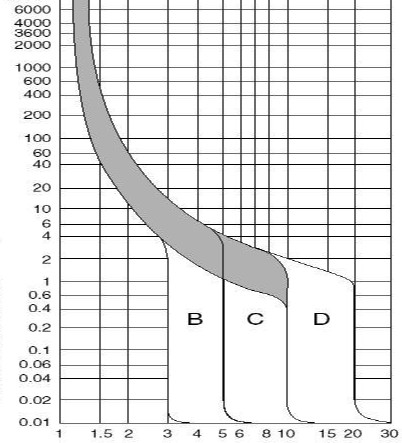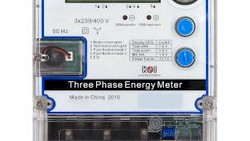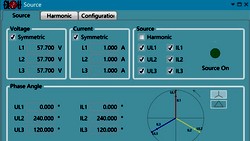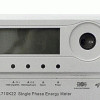Electronic meters with build-in relays can serve for various functionalities. By IEC62052-11 Ed.2 the name for this sort of relays is Supply Control Switch (SCS).
The meter functions can be highly customized as there are no specifications for disconnections related to events. One customer requested function is the disconnection upon over-current.
Which protection does this function offer?
All electrical installations have to be protected by fuses or circuit breakers. For domestic premisses you find the protection on the supply side, close to the meter.
In most cases this protection is done by a miniature circuit breaker (MCB) or by a moulded case circuit breaker (MCCB).
We take a look at the switching characteristics. For domestic protection usually the curve C or curve D are used.

Horizontal axis = multiple of the rated current
Vertical axis = time in seconds until trip
Circuit breakers have two tripping mechanisms:
a) magnetic
This is a very fast reaction on rapidly increasing currents leading to an almost instantaneous tripping. It's classified with B, C or D characteristic.
b) thermal
It's a slow reaction on a slightly over-current
Circuit breakers are specified in:
DIN/EN/IEC 60898-1 respective VDE 0641-11
Example: We have a meter with a maximum current of 80 A. On the supply side is an MCB with 80 A curve D.
In case of short circuit the circuit breaker reacts within 20 ms. If the current is 10 times higher the breaker trips latest after 1 second. (Manufacturer data sheets apply, this is only very basic information.)
If the current is increased by factor 1.2, the same circuit breaker will trip after 6000 seconds (100 minutes).
With help of the current disconnect function the meter can disconnect the load earlier to avoid the MCB tripping. Especially when meters are mounted on a pole, the breaker is not easy accessible. If ordered and activated, this function triggers on currents > 120% Imax, disconnects after a duration of 60 seconds and reconnects the load after 60 seconds.

The energy meter- or user interface unit display indicates the over-current and toggles every 2 seconds to show the remaining disconnection time.
Does it harm the meter if this function is not in use?
By design all CLOU energy meters have a supply control switch with current switching capability of 20 A more than the meter rating. In case of an 80 A meter we have 25% security margin. So there will be no harm for the meter. Frequent readers of this blog know that this margin is not for misuse.![]() A supply side protection is mandatory! See the original wording from IEC 62052-11:
A supply side protection is mandatory! See the original wording from IEC 62052-11:
The supply control switch should not be confused with the supply side protection device that is external to the meter and disconnects the supply in the case of an over-current fault.
Conclusion
The over-current disconnection can be useful in some cases, where the domestic installation does not protect all customer appliances properly. Usually there is a distribution box with smaller rated MCBs behind the meter on the load side. These MCBs capture eventually faults earlier.
Thank you for reading. If you have this function implemented, please share your experience with us. If you are planning to source new meters, talk to us. We are specialists for customized solutions.
Editor's note: This article was originally published in October 2020 and has been updated for comprehensiveness.





In this case to my understanding it means there is no need to install an RCD in other cut power so as to work in the fuse distribution box. How then do I work safely to avoid electric shocks?
Thank you for your comment. You have to install an RCD. The disconnect function of the smart meter supports an earlier disconnection once the current reaches the preset limit. This disconnect function does not replace the mandatory safety installations (RCD, MCCB, fuse). There is also no protection against short-circuit.
I strongly recommend, you read the article again. Take also a look at the disconnection curves for breakers. These functionalities, an energy meter can't deliver. In addition, maintain the basic rules for personal safety.